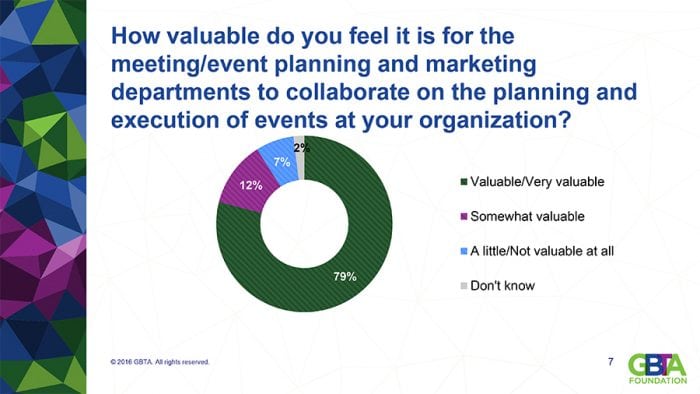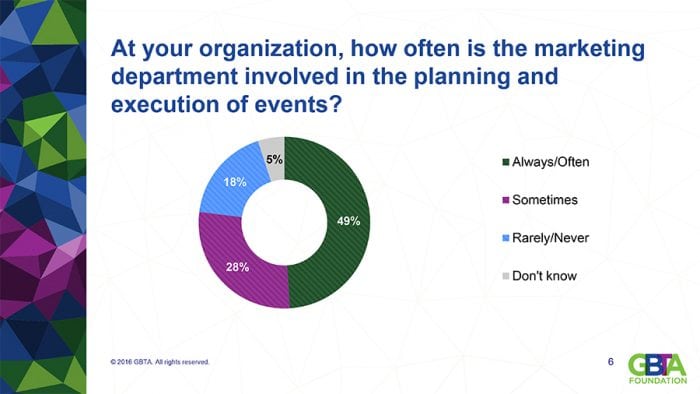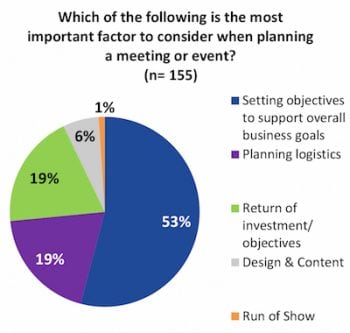Skift Take
Event planners and marketers need to combine forces more aggressively to co-create large meetings and conferences, because the next generation of interdisciplinary event design and experiential marketing is far too complex for planners to navigate on their own anymore.
A surprising 91 percent of business event planners believe that it’s valuable to work with the marketing department of the organization they’re planning conferences for, according to a new study released this week by the Global Business Travel Association (GBTA).
The purpose of the study — “Cross-Departmental Collaboration: When Event Planning Meets Marketing” — is to explore the challenges that event planners and marketers face when collaborating together to produce events. In February, GBTA interviewed 10 senior North American planners responsible for producing large-scale conferences. Those interviews then informed the direction of a supplemental online survey of another 157 planners with varying degrees of event design responsibilities.
More companies and organizations these days are designing their conferences as consumer-facing, experiential brand marketing platforms, expanding beyond their traditional business event purposes such as networking, education, product launches, and sales training.
Salesforce’s annual Dreamforce conference this week is a good example of that. In 2003, the company attracted 1,300 attendees to hear a couple of tech industry keynotes. Ten years later in 2013, more than 130,000 swarmed the San Francisco event to hear Bruno Mars.
For event planners and marketers to successfully work with each other, it requires people with different skills sets in different departments to sit down at the same table. That’s easier said than done.
Event planners are obsessive, compulsive, detail-oriented, sleep-deprived professionals responsible for logistics, mobility, and an endlessly evolving trail of granular to-do lists. Marketers, meanwhile — and yes, this is a gross generalization — tend to be more right-brained and subjective with a nuanced grasp of brand storytelling and audience engagement. Planners are buried in line items and the cost of each, while marketers focus more on the “big idea” than the budget.
So, the fact that more than 9 in 10 planners think it’s at least somewhat valuable to hook up with marketers to co-create event programs, bringing more cooks into the kitchen to help stir the pot, illustrates the willingness of senior planners to reach across the aisle.
What makes this GBTA report interesting, it’s the first empirical look at the road blocks standing in the way of effective, strategic collaboration between event planning and promotion. While the report’s sample size is relatively small, the results paint a more qualitative, real-world look at the obstacles causing friction between planners and marketers.
The planners surveyed in this study responded that their five main challenges when working with marketers are: A lack of cross-departmental communication, control issues and organizational structure between departments, budget constraints, timeline delays, and aligning marketing’s event goals with the event planner’s program structure.
The worries around who’s in control and the need for organizational structure stand out in that list. More so than all of the other concerns combined, that is where leadership needs to address planner and marketer roles clearly upfront.
Adding to the challenges, only 49 percent of planners reported that they always or often work with marketers. Even though another 28 percent say they do so occasionally, there’s an obvious gap between how planners value collaboration and how many of them actually have the opportunity to do so.
the Event Design & Content Conundrum
The most illuminating survey question in the GBTA report is: “Which of the following is the most important factor to consider when planning a meeting or event?”
The top responses are: “Setting objectives to support overall business goals” (53%), “Planning logistics” (19%), and “Return of investment/objectives” (19%).
Somewhat unexpected, only six percent of event planners chose “Design & Content.” Meaning, the actual event experience and event deliverables developed for attendees — the end users who ostensibly events are created for — are an afterthought for the vast majority of event planners.
From an event industry standpoint, especially among younger generations, the conversation around event design and interdisciplinary content, and how they create attendee engagement, is driving every disruptive trend that’s reimagining live events today worldwide. That fact that planners don’t prioritize design and content speaks to the fact that so many are simply overwhelmed and/or completely distanced from the subject.
That’s why there’s growing demand for planners to collaborate more with marketers, because marketers understand the critical role that design and content play in today’s world of brand engagement marrying online and offline experiences.
The report reads: “Thinking beyond logistics, only six percent of event planners feel the design and content of a meeting or event is the most important part of planning, but that does not make it any less vital to the success of an event. It is possible that because this area is less familiar to event planners, its value is not as readily understood or reported, leading them to look beyond themselves and their department for help closing this gap.”
It seems more than possible, and it goes to the heart of the fragmentation rampant in much of the events industry.
Have a confidential tip for Skift? Get in touch
Tags: gbta, meetings and events
Photo credit: As brands focus more on high-impact, experiential event marketing strategy, event planners and marketers are collaborating more than ever before. FreemanXP



